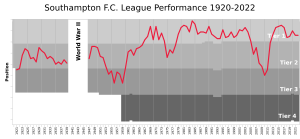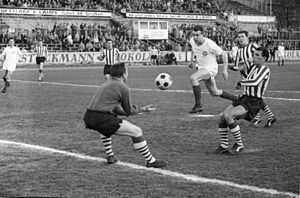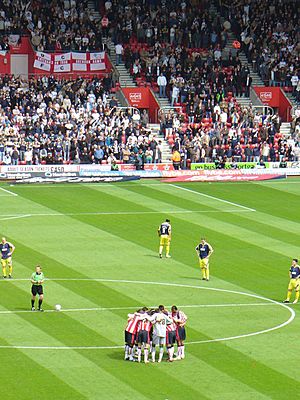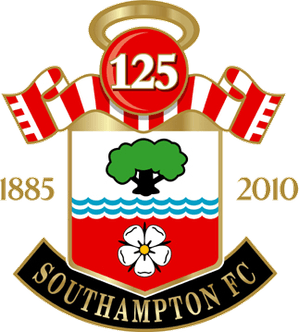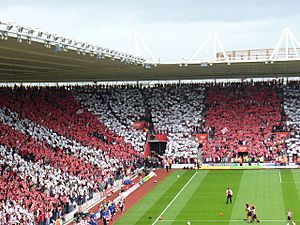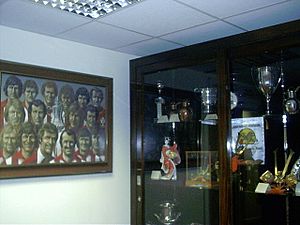Southampton F.C. facts for kids
 |
|||
| Full name | Southampton Football Club | ||
|---|---|---|---|
| Nickname(s) | The Saints | ||
| Founded | 21 November 1885 (as St. Mary's Y.M.A.) |
||
| Ground | St Mary's Stadium | ||
| Capacity | 32,384 | ||
| Owner | Sport Republic | ||
| Chairman | Dragan Šolak | ||
| Manager | Will Still | ||
| League | Premier League | ||
| 2018–19 | Premier League, 16th of 20 | ||
|
|
|||
Southampton Football Club is a professional football team from Southampton, Hampshire, England. They play in the EFL Championship, which is the second-highest league in English football. Their home stadium is St Mary's Stadium, where they have played since 2001. Before that, they played at The Dell. The team wears red and white shirts. They are called "The Saints" because the club started as a church football team at St Mary's Church. Southampton has a big rivalry with Portsmouth, called the South Coast derby. This is because the two cities are close and both have a long history with the sea.
The club began in 1885. They joined the Southern League in 1894 as Southampton St. Mary's. Three years later, they dropped "St. Mary's" from their name. Southampton won the Southern League six times. They also reached the FA Cup final in 1900 and 1902, but lost both times. In 1920, they became one of the first teams in the Football League Third Division. They won promotion in 1921–22 and stayed in the Second Division for 31 years. They were relegated in 1953.
Under manager Ted Bates, they won the Third Division in 1959–60. They were promoted to the First Division in 1965–66. They played in the top league for eight seasons. In 1976, while still in the Second Division, they won the FA Cup. They beat Manchester United 1–0 in the final. Manager Lawrie McMenemy then led them back to the top league in 1977–78.
Southampton reached the League Cup final in 1979, but lost. They finished second in the First Division in 1983–84, just three points behind Liverpool. The club was one of the founding members of the Premier League in 1992. They reached another FA Cup final in 2003. In 2005, they were relegated, ending their 27-year stay in the top league. They went down to the third tier in 2009.
Southampton won the Football League Trophy in 2010. They then earned two promotions in a row, from League One in 2010–11 and the EFL Championship in 2011–12. After 11 years in the top league, they were runners-up in the EFL Cup in 2017. They were relegated in 2023. However, they won the 2024 Championship play-off final and returned to the Premier League quickly. They were relegated back to the Championship in April 2025.
Contents
- Club History
- How the Club Started (1885–1920)
- Joining the Football League (1920–1966)
- Reaching the Top League and Cup Win (1966–1977)
- Back in the First Division (1977–1992)
- Southampton in the Premier League (1992–2005)
- Outside the Top League (2005–2012)
- Back in the Premier League (2012–2023)
- Recent Promotions and Relegations (2023–Present)
- Club Identity
- Stadium and Training Facilities
- Club Rivalries
- Club Records and Statistics
- Players
- Club Management
- Club Achievements
- See also
Club History
How the Club Started (1885–1920)
Southampton Football Club began on November 21, 1885. It was started by members of the St. Mary's Church of England Young Men's Association.
In the early days, the team, often called St. Mary's Y.M.A., played on The Common. Games were sometimes stopped by people walking around. Important matches, like cup games, were played at the County Cricket Ground or the Antelope Cricket Ground.
The club was first known as St. Mary's Young Men's Association F.C. Then it became St. Mary's F.C. in 1887–88. When they joined the Southern League in 1894, they changed their name to Southampton St. Mary's.
To start their league journey, Saints signed professional players. These included Charles Baker and Alf Littlehales. After winning the Southern League title in 1896–97, the club became a company and was renamed Southampton F.C..
Southampton won the Southern League championship three years in a row from 1897 to 1899. They won it again in 1901, 1903, and 1904. During this time, they moved to a new stadium called The Dell in 1898. It cost £10,000 to build. They played there for 103 years.
The club reached its first FA Cup Final in 1900, losing 4–0 to Bury. Two years later, they lost 2–1 to Sheffield United in a replay of the 1902 final. Reaching these finals made Southampton famous. In 1909, a representative from Athletic Bilbao bought 50 Saints shirts. This is why both Athletic Bilbao and Atlético Madrid now wear red and white.
Joining the Football League (1920–1966)
After World War I, Southampton joined the new Football League Third Division in 1920. A year later, it split into Southern and Northern sections. The 1921–22 season was a success, with the team winning promotion. This started a 31-year period in the Second Division.
The 1922–23 season was very balanced. Southampton had 14 wins, 14 draws, and 14 defeats. They finished in the middle of the table.
In 1925 and 1927, they reached the FA Cup semi-finals. They lost to Sheffield United and Arsenal.
During World War II, a bomb hit The Dell pitch in November 1940. It left a large hole and flooded the field. Southampton had to play their home games at Portsmouth's stadium, Fratton Park, for a short time.
They almost won promotion in 1947–48 and 1948–49, finishing third both times. In 1949–50, they just missed out on promotion again. Striker Charlie Wayman scored 56 goals in those two seasons. But in 1953, Southampton was relegated back to Division 3 (South).
It took until 1960 for Southampton to return to the Second Division. Derek Reeves scored 39 of the team's 106 league goals that season. On April 27, 1963, 68,000 fans watched them lose 1–0 to Manchester United in the FA Cup semi-final.
Reaching the Top League and Cup Win (1966–1977)
In 1966, Ted Bates' team was promoted to the First Division. They finished as runners-up. Martin Chivers scored 30 goals for Saints that season.
The next season, Ron Davies joined and scored 43 goals. Saints stayed in the top league for eight years. Their best finishes were seventh place in 1968–69 and 1970–71. These high finishes allowed them to play in European competitions. They played in the Inter-Cities Fairs Cup in 1969–70 and the UEFA Cup in 1971–72.
In December 1973, Bates stepped down. His assistant, Lawrie McMenemy, took over. Saints were one of the first teams to be relegated under a new system in 1974.
Under McMenemy, Saints started to rebuild in the Second Division. They signed players like Peter Osgood and Jim McCalliog. In 1976, Southampton reached the FA Cup final. They played Manchester United at Wembley and won 1–0 with a goal from Bobby Stokes. The next season, they played in Europe again in the Cup Winners' Cup. They reached the third round before losing to Anderlecht.
Back in the First Division (1977–1992)
In 1977–78, with Alan Ball as captain, Saints finished second in the Second Division. This meant they returned to the First Division. They finished 14th in their first season back. The next season, they reached the League Cup final at Wembley. They played well but lost 3–2 to Nottingham Forest.
In 1980, McMenemy made a big signing: European Footballer of the Year Kevin Keegan. Keegan played for Southampton for two years. The team also had Alan Ball, Ted MacDougall, Phil Boyer, Mick Channon, and Charlie George. In 1980–81, they scored 76 goals and finished sixth, their highest league finish at the time. The next season, Kevin Keegan helped the club reach the top of the First Division. Southampton led the league for over two months. But they only won two of their last nine games and finished seventh. Liverpool won the title. Keegan scored 26 goals that season before being sold to Newcastle.
Southampton continued to improve under McMenemy. The team included Peter Shilton (the England goalkeeper), Nick Holmes, David Armstrong, Steve Moran, and Danny Wallace. They achieved their highest-ever league finish, coming second in 1983–84. They were three points behind champions Liverpool. They also reached the FA Cup semi-final, losing to Everton. McMenemy then added experienced midfielder Jimmy Case.
They finished fifth the next year. However, due to the Heysel Disaster, English clubs were banned from European competitions. Otherwise, Southampton would have qualified for the UEFA Cup.
McMenemy left in 1985. Chris Nicholl took over but was sacked after six years. He was replaced by Ian Branfoot. By this time, a key player was Guernsey-born attacking midfielder Matthew Le Tissier. He joined the first team in 1986–87. He was named PFA Young Player of the Year in 1990. Another exciting young player was Alan Shearer. At 17, he scored three goals against Arsenal in 1988. Shearer was a regular by 1990. He stayed until 1992 when he was sold to Blackburn Rovers for over £3 million. He later became the world's most expensive footballer when he moved to Newcastle for £15 million in 1996. He also scored 30 goals for England.
Southampton in the Premier League (1992–2005)
Southampton was one of the founding teams of the Premier League in 1992–93. For the next ten seasons, they often struggled to avoid relegation. In 1995–96, Southampton finished 17th. They avoided relegation by goal difference. Important wins against Manchester United and Bolton Wanderers helped them stay up.
Former Liverpool manager Graeme Souness joined. He signed foreign players like Egil Østenstad and Eyal Berkovic. A highlight was a 6–3 win over Manchester United in October. Both new signings scored twice. Souness left after one season. Dave Jones replaced him.
In 1998–99, they were at the bottom of the table for a long time. But they avoided relegation on the last day. This was helped by Marian Pahars and Le Tissier. In 1999, Southampton got permission to build a new 32,000-seat stadium. The Dell, their old stadium, had a capacity of less than 16,000.
During the 1999–2000 season, Dave Jones left. He was replaced by former England manager Glenn Hoddle. Hoddle kept Southampton safe from relegation. But he moved to Tottenham Hotspur before the 2000–01 season ended. First-team coach Stuart Gray took over. He oversaw the move to the St Mary's Stadium for the 2001–02 season. In the last game at The Dell, Matthew Le Tissier scored the final league goal in a 3–2 win against Arsenal. Gray was sacked after a bad start to the next season. Former Coventry City manager Gordon Strachan replaced him. Strachan led Southampton to safety and an 11th-place finish.
In 2002–03, Southampton finished eighth in the league. They were also runners-up in the FA Cup to Arsenal, losing 1–0. This was thanks to James Beattie, who scored 24 goals. Strachan resigned in March 2004. Within eight months, two more managers, Paul Sturrock and Steve Wigley, came and went. Chairman Rupert Lowe then appointed Harry Redknapp as manager in December 2004. Redknapp had just left rivals Portsmouth. He brought in new players, including his son Jamie. But Southampton was relegated from the Premier League on the last day of the season. This ended their 27 years in the top league. Their relegation was confirmed by a 2–1 home defeat to Manchester United.
Outside the Top League (2005–2012)
In November 2005, manager Harry Redknapp left to rejoin Portsmouth. George Burley replaced him. Rupert Lowe resigned as chairman in June 2006. Michael Wilde, a businessman from Jersey, became the club's main shareholder and chairman. The club spent a record £6 million on new players. Polish strikers Grzegorz Rasiak and Marek Saganowski played well. Young Gareth Bale also joined the team. Southampton finished sixth and lost in the play-off semi-final to Derby County.
The board looked for new investors. In February 2007, Wilde stepped down. Local businessman Leon Crouch became "Acting chairman." In the 2007–08 season, George Burley said players like Bale had to be sold to prevent financial problems. Burley left in January 2008 to manage Scotland. Nigel Pearson replaced him and saved the club from relegation on the final day.
In July 2008, most board members resigned. Lowe and Wilde returned. Pearson's contract was not renewed due to money problems. Jan Poortvliet became manager. Financial troubles continued. More players were sold, and parts of St Mary's Stadium were closed. In January 2009, Poortvliet resigned. Mark Wotte took over.
In April 2009, Southampton's parent company went into administration. They received a 10-point penalty. This penalty applied to the 2009–10 season because the team was already being relegated. By May, the club could not pay its staff. The administrator warned that the club faced bankruptcy without a buyer. In June, the club was sold to an overseas buyer owned by Markus Liebherr. Italian businessman Nicola Cortese was brought in to manage the club's business. In July 2009, Wotte was sacked. Alan Pardew was appointed manager. The Saints made their first big signing under Liebherr, striker Rickie Lambert.
Southampton started the 2009–10 season in League One, the third tier, for the first time in 50 years. They began with -10 points. In March 2010, Southampton won their first trophy since 1976. They beat Carlisle United 4–1 at Wembley to win the Football League Trophy. Southampton finished seventh that season.
A new home shirt was revealed on June 10, 2010, for the club's 125th anniversary. It was based on the original 1885 St. Mary's Y.M.A. kit. On August 11, it was announced that Liebherr had died. However, the club's future was secure. Pardew was dismissed in August. Nigel Adkins joined as his replacement. The club was promoted to the Championship in May 2011.
Returning to the Championship for the 2011–12 season, Southampton had their best start in 75 years. They won 13 league games in a row at St. Mary's, setting a new club record. In April 2012, Southampton won promotion to the Premier League. The final game of the season had a record attendance of 32,363 at St Mary's Stadium. Lambert was the Championship's top goalscorer with 27 goals. He also won the Championship Player of the Year award. They became the second team in a year to achieve back-to-back promotions.
Back in the Premier League (2012–2023)
Southampton returned to the Premier League for the 2012–13 season with Nigel Adkins as manager. They spent a lot of money on new players. But early in the season, Adkins was replaced by Argentine coach Mauricio Pochettino. Southampton finished 14th that season, and eighth the next season.

At the end of the 2013–14 season, Pochettino left for Tottenham. The club then appointed Ronald Koeman as his replacement. They also sold several key players that summer. In the last game of the 2014–15 season, a 6–1 win against Aston Villa, Sadio Mané scored three goals in just 176 seconds. This was the fastest hat-trick in Premier League history. The club finished seventh, their highest Premier League rank at the time. This meant they qualified for the 2015–16 UEFA Europa League. They were eliminated in the play-off round. The next season, Southampton finished sixth, setting a new club record. They qualified for the Europa League group stages.
In June 2016, Koeman left to join Everton. Claude Puel replaced him. The club was knocked out of the Europa League group stage. However, they did well in the EFL Cup. They lost 3–2 in the final to Manchester United. The club finished eighth in the 2016–17 season. Puel was replaced by Argentine coach Mauricio Pellegrino.
In mid-season, the club sold Dutch defender Virgil van Dijk to Liverpool for about £75 million. This was Southampton's record sale and a world record for a defender. Pellegrino was sacked in March 2018. His replacement, former player Mark Hughes, guided the club to a 17th-place finish, avoiding relegation. Hughes signed a new contract, but a poor start to the next season led to him being sacked in December. He was replaced by former RB Leipzig boss Ralph Hasenhüttl, who helped the club finish 16th.
In August 2017, Chinese businessman Gao Jisheng bought an 80% share of the club for around £210 million. This deal followed over a year of talks.
Southampton suffered their worst-ever defeat on October 25, 2019, losing 9–0 to Leicester City at home. This happened again on February 2, 2021, against Manchester United at Old Trafford. These are tied for the biggest defeats in Premier League history. After the first loss, the players and coaching staff gave up their wages from the match. They donated them to the Saints Foundation. On April 9, 2020, Southampton was the first Premier League club to delay players' salaries during the COVID-19 pandemic. Despite a bad start, Southampton improved greatly and finished 11th. Their 52 points was the team's highest total since 2015–16.
The club's good form continued in the 2020–21 season. The Saints were third after 13 games. They also reached the FA Cup semi-finals, losing to Leicester City. In November, Southampton briefly led the Premier League table. However, injuries and training restrictions due to the lockdown affected the team. Hasenhüttl had to use many youth players. Southampton finished 15th. In January 2022, Gao sold his 80% stake to Sport Republic, a group funded by Serbian Dragan Šolak, for £100 million. Southampton finished 15th again in 2021–22.
In November 2022, Southampton parted ways with manager Ralph Hasenhüttl. Nathan Jones replaced him. On February 12, 2023, Jones was sacked after a bad run of results. Rubén Sellés became caretaker manager and then permanent manager. Sellés could not save the season. The team was relegated on May 13, 2023, after losing to Fulham. On May 24, 2023, Southampton confirmed Sellés' contract would not be renewed.
Recent Promotions and Relegations (2023–Present)
On June 21, 2023, the club appointed Russell Martin as manager. Southampton returned to the Premier League quickly. They beat Leeds United in the play-off final. On December 15, 2024, Martin was sacked as Southampton was last in the Premier League. Simon Rusk, the Southampton U-21s head coach, took over temporarily. Six days later, Ivan Jurić was appointed manager. The club was relegated from the Premier League on April 6, 2025. This made them the earliest team to be relegated in Premier League history. Jurić left after relegation. Rusk became interim manager again. On the final matchday of the season, Will Still was announced as the new manager for the next season.
Club Identity
Club Crest
At first, the club used the same crest as the city of Southampton. But in 1974, they held a competition for fans to design a new one.
The winning design, by Rolland Parris, was used for about 20 years. It was changed slightly in the 1990s for copyright reasons.
The halo at the top refers to the nickname "Saints." The ball shows it's a football club. The scarf represents the fans and team colours. The tree stands for the nearby New Forest and Southampton Common. The water shows Southampton's connection to rivers and the sea. Below that is a white rose, the symbol of the city. In the mid-1990s, the football on the crest was updated to a modern black and white panelled ball.
On May 13, 2010, the official crest for the club's 125th anniversary was released. The black outline and halo became gold. The years 1885 and 2010 were added, and "125" replaced the ball. This badge was used on Southampton's shirts for the 2010–11 season.
Club Anthem
Southampton's anthem is the famous song "When the Saints Go Marching In." Since the club's nickname is "the Saints," they are one of the few teams that sing the original lyrics.
Kit Makers and Sponsors
Many companies have sponsored Southampton's shirts since advertising was allowed. The first was Rank Xerox in 1980. Other sponsors have included Air Florida, Draper Tools, Dimplex, Sanderson, Friends Provident, Flybe, aap3, Veho, Virgin Media, LD Sports, Sportsbet.io, and Rollbit. Since 2025, P&O Cruises has been the main shirt sponsor. Virgin Media was also a sleeve sponsor from 2017 to 2022. JD Sports and Mairon Freight UK have also been sleeve sponsors. Since 2024, P&O Cruises has also been the sleeve sponsor.
Since 2024, Puma has made Southampton's kits. Past manufacturers include Umbro, Admiral, Patrick, Hummel, Pony, Adidas, and Under Armour. From 1999 to 2008, and in 2014–15, the club made its own kits under the brand "Saints."
| Period | Kit manufacturer | Shirt sponsor (front) | Shirt sponsor (sleeve) | Shirt sponsor (back) |
|---|---|---|---|---|
| 1974–1976 | Umbro | No sponsor | No sponsor | No sponsor |
| 1976–1980 | Admiral | |||
| 1980–1983 | Patrick | Rank Xerox | ||
| 1983 | Air Florida | |||
| 1984–1987 | Draper Tools | |||
| 1987–1991 | Hummel | |||
| 1991–1993 | Admiral | |||
| 1993–1995 | Pony | Dimplex | ||
| 1995–1999 | Sanderson | |||
| 1999–2006 | Saints | Friends Provident | ||
| 2006–2008 | Flybe | |||
| 2008–2010 | Umbro | |||
| 2010–2011 | No sponsor | |||
| 2011–2013 | aap3 | |||
| 2013–2014 | Adidas | Veho | ||
| 2014–2015 | Saints | |||
| 2015–2016 | Adidas | |||
| 2016–2017 | Under Armour | Virgin Media | ||
| 2017–2019 | Virgin Media | |||
| 2019–2020 | LD Sports | |||
| 2020–2021 | Sportsbet.io | |||
| 2021–2022 | Hummel | |||
| 2022–2023 | JD Sports | |||
| 2023–2024 | Mairon Freight UK | Draper Tools | ||
| 2024–2025 | Puma | Rollbit | P&O Cruises | Rollbit (in FA Cup matches) / Garmin (in EFL Cup matches) |
| 2025– | P&O Cruises |
Stadium and Training Facilities
The club's first home ground was the Antelope Ground from 1887 to 1896. Then they played at the County Cricket Ground from 1896 to 1898.
From 1898 to 2001, Southampton played at The Dell. This stadium was built just for the club. It was updated many times. In 1950, it was the first ground in England to have permanent floodlights. After a report called the Taylor report, The Dell became an all-seater stadium. But it could only hold about 15,000 fans, making it the smallest in England's top league. This led to the move to a new home.
St Mary's Stadium has been the Saints' home since August 2001. It can hold 32,689 people. It is one of the few stadiums in Europe that meets UEFA's Four Star standards. The stadium has also hosted international games. The record attendance at the ground is 32,363, set in a game between Southampton and Coventry City in April 2012.
The club's training facilities, Staplewood Campus, are in Marchwood. They are on the edge of the New Forest. The current facilities opened in November 2014 and cost about £40 million. The main building is named after the club's late owner, Markus Liebherr.
For a few seasons, the club's U21 team played at Eastleigh's stadium, Ten Acres. This continued a partnership that lasted almost ten years. This partnership ended, and Southampton's youth teams now play at Staplewood and St. Mary's. Some U23 cup games are played at Totton's Testwood Stadium, where Southampton Women play their home matches.
Club Rivalries
The South Coast Derby is the name for matches between the Saints and their big rivals, Portsmouth. Portsmouth is a city 19 miles (31 km) from Southampton. These derbies are also called the Hampshire derby. Including Southern League games, the two clubs have played 71 times. Southampton has won 35 games, and Portsmouth has won 21.
Club Records and Statistics
Longest winning streak
- 10 matches, April 16, 2011 – August 20, 2011 (League games)
- 11 matches, April 16, 2011 – August 20, 2011 (All competitions)
Longest unbeaten streak
- 22 matches, September 30, 2023 – February 10, 2024 (League games)
- 25 matches, September 30, 2023 – February 10, 2024 (All competitions)
Longest home winning streak
- 19 matches, February 12, 2011 – November 29, 2011 (League games)
- 21 matches, February 12, 2011 – November 29, 2011 (All competitions)
Biggest wins
- Home
- 11–0 against Northampton Town, December 28, 1901 (Southern League)
- 11–0 against Watford, December 13, 1902 (Southern League)
- 8–0 against Northampton Town, December 24, 1921 (Football League Third Division South)
- 8–0 against Sunderland, October 18, 2014 (Premier League)
- Away
- 8–0 against Newport County, August 25, 2021 (EFL Cup)
- 6–0 against Carlisle United, January 22, 1977 (Football League Second Division)
- 6–0 against Wolverhampton Wanderers, March 31, 2007 (Football League Championship)
- 6–0 against Oldham Athletic, January 11, 2011 (Football League One)
Biggest losses
- Home
- 0–9 against Leicester City, October 25, 2019 (Premier League)
- 0–6 against Plymouth Argyle, December 5, 1931 (Football League Second Division)
- 0–6 against Brentford, March 9, 1959 (Football League Third Division)
- Away
- 0–9 against Manchester United, February 2, 2021 (Premier League)
- 0–8 against Crystal Palace, November 16, 1913 (Southern League)
- 0–8 against Tottenham Hotspur, March 28, 1936 (Football League Second Division)
- 0–8 against Everton, November 20, 1971 (Football League First Division)
Highest scoring Football League game
- 9–3 (at home) against Wolverhampton Wanderers, September 18, 1965 (Football League Second Division)
Record home attendance
- 32,363 against Coventry City, April 28, 2012
Player Records
Most appearances
- Terry Paine – 815 games: 1956–1974
Most goals
- Mick Channon – 228 goals: 1966–1977, 1979–1982
Most goals in one season
- Derek Reeves – 44 goals: 1959–60
Most goals in one match
- Albert Brown – 7 goals: against Northampton Town, December 28, 1901
Youngest player
- Theo Walcott – 16 years 143 days. Against Wolverhampton Wanderers, August 6, 2005
Oldest player
- Willy Caballero – 41 years 122 days. Against Blackpool, January 28, 2023
Highest transfer fees
- Spent: Kamaldeen Sulemana – £22 million paid to Rennes.
- Received: Virgil van Dijk – £75 million received from Liverpool.
Players
Current Squad
|
|
Players on Loan
|
Youth Teams and Academy
Southampton has a very successful youth academy. It has teams for players from ages eight to 21. Many famous players have come from this academy. These include England international players like Adam Lallana, Alex Oxlade-Chamberlain, James Ward-Prowse, Calum Chambers, Luke Shaw, and Theo Walcott. Also, Wales international winger Gareth Bale and Ireland international striker Michael Obafemi.
Famous Former Players
Club Management
|
|
Manager History
Club Achievements
Here are some of the main trophies and achievements of Southampton Football Club:
League Titles
- First Division (top league)
- Second Place: 1983–84
- Second Division / Championship (second league)
- Second Place: 1965–66, 1977–78, 2011–12
- Play-off Winners: 2024
- Third Division South / Third Division / League One (third league)
- Champions: 1921–22, 1959–60
- Second Place: 2010–11
- Southern League
- Champions (6 times): 1896–97, 1897–98, 1898–99, 1900–01, 1902–03, 1903–04
Cup Wins
- FA Cup
- Winners: 1975–76
- Runners-up: 1899–1900, 1901–02, 2002–03
- Football League Cup / EFL Cup
- Runners-up: 1978–79, 2016–17
- Football League Trophy
- Winners: 2009–10
- Full Members' Cup
- Runners-up: 1991–92
See also
 In Spanish: Southampton Football Club para niños
In Spanish: Southampton Football Club para niños


